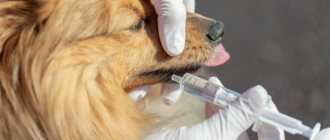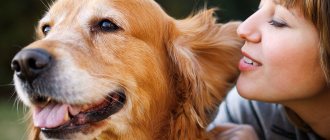Without correctly understanding the language of dogs, it is difficult to establish contact with your pet and instill in him the necessary behavioral skills. Of course, there is no universal translator or special dictionary for deciphering dog language, because each dog is individual. But there are certain signs by which you can draw a conclusion about the dog’s mood, having learned to interpret them correctly. If you want to learn how to understand your pet correctly, we recommend reading this review.
Dog tongue
From their ancestors, wolves, dogs inherited a certain system of expressing their emotions. To communicate with relatives and people, they use facial expressions, postures, and voice. Dogs are social creatures and perceive family members as a pack where hierarchy rules.
Important! Dogs never lie or hide their true feelings. Carefully observe the habits and manners of the animal at home and on walks. Analyze when the dog growls, barks, wags its tail, and you will accurately learn to understand your pet.
By correctly interpreting what the dog wants to convey to us, carefully observing gestures, postures, and body movements, you can understand how the pet feels and what its mood is. This will allow you to predict his behavior and react in a given situation.
Dogs experience:
- joy, goodwill;
- fear, stress, tension;
- aggression, irritation;
- dominance, readiness to attack;
- submission, humility.
Our little brothers express their emotions with their eyes, tail, certain poses, movements, voice, and facial expressions. They make many sounds and gestures, which can be used to determine the pet’s further intentions.
How dogs express their feelings
People who are accustomed to living next to dogs intuitively understand the meaning of the basic body movements performed by the animal. The owner will most likely be able to understand when his pet is angry, when he is offended, and when he is in a joyful state. Dogs can express their feelings not only with their voice, but also with their body language.
The body language of dogs and humans is significantly different. A person, understanding a certain facial expression, posture or animal movements as one thing, must understand that for a dog this means something completely different.
The basis of a dog's body language includes several main parts:
- facial expression of emotional state;
- change in the position of the ears;
- characteristic tail movements and changes in body position.
Understanding a dog’s body language and deciphering certain emotions experienced by the animal is possible only with an integrated approach.
Learning to understand your dog
So that there is no misunderstanding between you and the dog, we will decipher the signs of the dog’s language. To extract more information about the animal's state, feelings and intentions, pay attention to all of your pet's behavior at the same time. Assess the condition comprehensively, this is the only way you can understand your pet.
Muzzle
Dogs' faces have different shapes and sizes. But every little face, regardless of breed, will tell its owners about the dog’s feelings.
Our little brothers express their emotions with their eyes. The expression, direction of gaze, and eye size change. So, if the pet is calm and balanced, his eyes will be in their usual state, his gaze will be calm.
If the dog is threatened by something, he is excited, scared, his eyes increase in size relative to their normal state. The pupil is dilated.
If the dog is interested in something or scared, its eyes appear smaller. If the pet is sick, feels unwell, the expression in the eyes becomes sad, the look dims. The dog looks sideways and reacts sluggishly to stimuli. A sideways glance speaks of submission, indicating that the dog has realized his guilt after disobedience.
Advice! If you feel that your pet is friendly towards you, do not look the dog in the eyes. This signal is perceived as a threat. If the dog looks with a “frozen” gaze, the dog is wary, slowly turn your head away and avert your eyes.
If a dog looks away, closes its eyes, turns away its muzzle when meeting its relatives, this means that it does not pose a threat and will not show aggression without a reason.
As a rule, dogs rarely look directly into each other's eyes, as this is a threat signal.
If the dog looks at you with a calm expression on its muzzle and tilts its head, the animal trusts and hopes for understanding. Frequent blinking when looking at any object is a call to play.
Why do cats have rough tongues?
On the surface of a cat's tongue there are capillary papillae. They are what make the organ rough. The papillae are keratinized, sharp projections that are directed toward the larynx. If an animal licks a person, discomfort will immediately appear.
Cat tongue
At the same time, a cat's tongue is multifunctional. Animals are extremely clean, so they constantly lick themselves (for more details, see our article: why cats wash themselves but dogs don’t). Essentially, the tongue replaces a comb and water procedures. Even street cats often look neat and clean. With the help of a rough tongue, it is possible to comb out even thick fur. The cat will not only lick itself, but also untangle the fluff.
Interesting fact: some scientists note that with the help of a rough tongue it is easier for a cat to separate meat from bones. The animal is a predator
For this reason, in the natural environment it is important for him to eat the entire prey.
In extreme heat, cats can use their tongue to regulate their body temperature, cooling the body. Actually, this also applies to dogs.
Disadvantages of a rough tongue
A rough tongue has a significant drawback. Due to the fact that the hooks on the surface are bent back, the fur and fluff partially remain in the oral cavity. The animal is forced to swallow whole clumps of hair. Most often, it is possible to get rid of fluff naturally. If the hair is long, then there is a risk of developing intestinal and stomach obstruction. The owner will have to treat the pet and give special medications.
Top articles: Long-tailed cat or margay
It also happens that, due to the structural features of the organ, the pet has to swallow an inedible object. The cat was playing with a small object, after which it got stuck in the mouth. The rough tongue does not allow you to get rid of the object, and you have to swallow it. A similar situation arises with Christmas tree rain or threads.
A cat cannot lick its wounds, because a rough tongue will cause irritation. At the same time, a person should not push away the animal if it decides to show its feelings. It is not typical for cats to lick their owner. Such a gesture speaks of the pet’s love.
Body position
Animals also use their bodies to express emotions or intentions. In a calm state, the muscles are relaxed, not tense, and the dog does not take positions uncharacteristic of its usual behavior. Movements are free, natural, body weight is evenly distributed on four paws.
Attracting the owner's attention, inviting him to play, the dog jumps, vigorously wagging its tail, whines softly, using various intonations, sits on its front legs, raising its croup, or is constantly in motion. This behavior indicates that the animal is friendly and in a good mood.
If the dog is scared, feels aggression from his relatives, he is tense, his movements are constrained. The pet freezes in place, bends its paws, lies on the ground, does not respond to stimuli, takes unnatural poses, focusing on a frightening object. When frightened, the dog does not make unnecessary movements, trying to appear smaller, and can run away from the owner.
Fear is indicated by muscle tremors, flattened ears, and tail. If the dog whines, cannot find a place for himself, constantly changes his location in the house or apartment, takes uncharacteristic poses, whines - he is experiencing discomfort, has suffered stress, or the pet is in pain.
The dog stretches forward on tense paws, stands straight, muscles tense - the dog challenges, showing its superiority. Perhaps the animal feels aggression and if two dogs take similar poses, it will end in a fight.
If the dog lies on its back, stretches out its paws, wags its tail, the pet trusts you, demonstrating its obedience, and in relation to its relatives this means recognizing the authority of another dog.
A raised paw is a signal of uncertainty and wariness. If the pet behaves quietly, lies down and rests its head on its front paws, it is completely subordinate to the owner or another dog.
How to understand a dog's body language
What a pet wants to say when it wags its tail or turns its head with interest following a person’s words is quite easy to understand.
She can tell about the emotions that a dog is experiencing through her body movements. Animal psychologists recommend paying increased attention to the positions of the dog’s ears and tail. It is these two parts of the body that are considered the most informative.
Each dog is an individual. The character of an animal depends on many factors - age, breed, upbringing and living conditions. You need to understand that not just one gesture, but a whole complex, will help to create a complete picture of understanding your pet.
Tail
Unlike cats, in which wagging their tail signifies anger, anxiety or activity to attack, in dogs this gesture is more peaceful. Sharp swings of the tail indicate the intense joy that the animal experiences. In some cases, tail wagging can indicate not only joy, but also great excitement.
An important factor in learning a dog's body language is the speed of the tail wagging. A dog can wag its tail either slowly or very quickly. A dog whose tail wags non-stop is considered friendly. If a person notices smooth, calm wagging of a dog’s tail, it means the animal is worried about something, wary.
A dog's tail that wags may be tense. This may be evidence of severe anxiety in the animal. Sometimes a tense tail indicates the presence of an individual of the opposite sex during the period of sexual hunting.
Tail movements may have different meanings for different dog breeds. For example, it is generally accepted that an animal, hiding its tail between its hind legs, experiences fear or excitement. But breeds such as the Greyhound, Irish Wolfhound and Whippet naturally have their tails curled between their paws. Therefore, talking about fear or excitement in a dog that bends its tail like this is groundless.
But still, a tail clamped between the hind legs is often evidence that the animal feels fear, is very frightened or worried. External circumstances, as well as postures and sounds, play a significant role in deciphering the state.
For example, when in a new, unfamiliar environment, a dog may be stressed, as evidenced by its tail between its legs. Also, your pet may be anxious due to timidity.
Barking
The timbre of the voice and the nature of the barking determine the dog’s state and intentions. Barking is a kind of dog language that is used to attract attention. It can mean joy, fear, aggression, threat, fear. The timbre and character of barking changes depending on the emotional state and situation. But barking does not always mean aggression or readiness to attack.
Important! The more aggressive the dog’s mood, the lower the timbre of the voice. If the dog is scared, the stronger and higher the sound of barking will be.
A quiet grunt or growl is a sign of dominance and may mean that the dog wants to show aggression.
Squealing, squeaking, howling, whining - the dog is scared, is in an unpleasant psychological, physical situation, and expresses his resentment. A high-pitched barking sound means the dog is in pain. A dog can howl from loneliness, melancholy, or inattention.
A prolonged vibrating high-pitched sound, squeaking, whining, accompanied by other emotions - signals of surprise, joy, attracting attention. Dogs can squeak when they are impatient, for example, while waiting to go for a walk or begging for a treat.
Normal Tongue Positions and Behavior
As mentioned, all dogs hold or hang their tongues out of their mouths, and there are many different reasons and situations that cause this.
Since dogs pant to cool down and their tongues have a large surface area, panting with an open mouth or sticking the tongue helps increase cooling as your dog inhales cooler air, which in turn helps cool the dog's body by transferring heat internally from the mouth and through the surface of the tongue.
Dogs also sometimes stick out their tongues or open their mouths to produce a faint or interesting scent, as dogs also have a scent organ called the Jacobson's Organ at the back of their mouth. Opening the mouth allows dogs to pick up scent particles that are "read" by this organ, and sticking the tongue allows it to pick up tiny scent particles as well.
If your dog smells something tasty or you're cooking dinner, this also triggers your dog's scent abilities and can cause them to salivate and drool and stick out their tongue!
This normal behavior and many others can cause your dog to stick out his tongue, and that is normal and normal - because your dog has control over the mobility of his tongue and can extend and retract it whenever he wants.
Looking for free pet advice for your dog?. Click here to join the UKs favorite pet community - PetForums.co.uk
Stress signals
The most common sedative signals used by dogs are:
- Turning your head is an attempt to calm down in a stressful situation;
- U-turn – calming down when feeling nervous;
- Freezing in immobility, slow movement is an attempt to calm the owner, and this behavior is often confused with the dog’s disobedience, for example, when trying to call the dog in an angry voice;
- Lying on his stomach is an encouraging behavior; a dominant dog encourages the approach of another animal that is afraid of him;
- Yawning is a calming behavior in a stressful situation;
- Licking is a greeting ritual and a calming signal. This is an infantile behavior, common in puppies and in submissive, dominant or fearful dogs, and its purpose is to avoid aggression;
- Physical intervention in conflict - a dog, suspecting an intention to fight between two individuals (humans or dogs), tries to prevent this by separating them with its own body.
In addition, you should pay attention to such behavior as:
- looking to the side;
- squinting;
- licking;
- dyspnea;
- raising one paw;
- falling to the ground;
- sitting;
- chills;
- urinating under oneself (this can also be a signal of submission and joy);
- falling on your back and exposing your stomach;
- immobility, pretending to be dead;
- sniffing;
- whining.
Skillful capture of these signals allows timely intervention, but ignoring these signals or misinterpreting them leads to the next stage of the dog's behavior in relation to aggression, i.e. preventive behavior.
General training course
The general training course is based on systematic training with the dog. The skills and abilities developed during the general course form the basis for the formation of conditioned reflexes in an animal. By the way, one of the first skills that a puppy is taught is the ability to go to the toilet only outside. During the training process, it is necessary to practice commands with gestures for dogs, and not just with your voice.
General skills and abilities include:
- response to nickname;
- habit of wearing a collar, leash, harness;
- approach to the trainer;
- walking nearby;
- the dog’s habit of lying down, sitting, standing, crawling;
- the ability to raise a voice, stop certain actions, and overcome certain obstacles;
- refusal of other people's food;
- tolerance to noise stimuli.
Can a dog take revenge and be mischievous?
The thinking of dogs is radically different from that of humans. They are by nature incapable of doing anything out of spite, out of revenge, out of harm, etc. “He knows not to pee on the bed, but he does it anyway! He knows that he will be punished, but he doesn’t stop - as soon as he’s distracted for a minute, he makes a puddle right on the pillow! He’s mischievous and pees out of spite!” No matter how confident the owner is that he is right, he is wrong. With such behavior, the pet is trying to tell us something. How to understand a dog? How to guess what she wants? Analyze your behavior, the behavior of family members, remember any changes in your usual routine
If a dog attracts attention in this way, it is unhappy and wants to correct the situation. Find the reason - solve the problem in a matter of days
The reason may also be in the dog itself - poor health, for example, often leads to the dog demanding increased attention, trying to convey to the person: “I’m in pain! Help me!
What not to do with a dog - prohibited signs
- We cannot allow a dog to feel power over us.
- You should not kiss a dog on the face under any circumstances - this is the behavior of a puppy showing submission to the bitch and older dogs, and can be read as a submissive gesture of the owner.
- It is forbidden to let the dog pass first when passing through the door. The dog must follow the owner.
- It is forbidden to allow a dog to sit in the owner's place without his permission.
- You need to look down on the dog, always stand above it, so that it knows that the person is the leader.
How to “establish yourself” in a dog’s eyes?
When we know what our dog really thinks, it becomes clear to us exactly how we can establish ourselves in the dog’s eyes as the leader of the pack. And you will be surprised to find that most of the problems, called training problems, will immediately disappear.
Let's start small: 1. You must ensure that the dog under no circumstances climbs onto beds, sofas and chairs. You should spend a small amount of time sitting in the dog seat. It would seem like a funny little thing, but it works flawlessly, oddly enough. 2. You must prepare food for the dog in his presence, but, having prepared it, first have a snack yourself; if you don’t want to, then do some business before giving the dog his portion. Compassionate owners, remember: this is not cruelty or torture for your dog! She doesn't suffer from this. Only by strictly following our recommendations will you simplify communication with your dog and make it enjoyable. 3. Make sure that all games are under your control: searches, hunting, returning various objects to the owner, treats, etc. Refuse to engage in power games with your dog, which we talked about above, and if you still have to, remember that you must come out a winner. 4. Always be aware of your right to be the first to enter the premises. Do not let the dog forward, and if he tries to break forward, then do it simply: hold him back, go through first and close the door behind you, leaving the dog on the other side for a while. The dog begins to wonder: what’s wrong? And, sooner or later, it will become clear to her that the owner should come in first and nothing else. This exercise is also good because with the door constantly closing in front of the dog’s nose, the dog quickly learns to take a step back. 5. The same thing happens on the street: if you call the dog, and it does not respond to the command “come to me,” Do not approach the dog under any circumstances. The dog must learn that it is not you who are approaching it, but it is approaching you, and it cannot be any other way! If the dog does not approach you, then simply turn around and walk slowly in the other direction, and you will see how it will rush towards you as fast as it can. 6. Force your dog to give way to you at home. Don't forget to do this!
We must make the dog earn all its privileges: a bowl of food, a walk, and so on. All demands should sound like commands: “Sit”, “Lie down”, “Stand”. Let these be simple commands, but the dog, if it wants something from us, must first earn it.
We must respond to all attempts to grab our arms or other parts of the body and clothing or chew (even while playing) on the leash with the loudest command, “Leave me alone!” and the most piercing gaze they can muster. When the dog obeys, you should not praise it.
These simple techniques reflect the rules that a dog can learn. With their help, our leadership and initiative in any activity are established. The most important thing is that order in your pack is established before you leave your home (den). For example, a dog's instincts dictate that it cannot go ahead of a higher-ranking member of the pack and that the leader holds the pack together. Therefore, if the dog gets the opportunity to drag you to the park with him or not to obey when you call him, then you are allowing him to increase his status and at the same time lose the opportunity to determine the terms of your relationship.
It should be noted that hundreds of dogs enjoy many privileges, and this does not affect their behavior. It should be emphasized that if you, the dog owner, are faced with control or behavior problems, then you need to analyze your relationship with the dog and see if you are, without realizing it, giving him advantages of a higher rank than those that he already has. You. You can change your position in the hierarchy if you do not allow the dog to take advantage of the advantages that are reserved for members of the pack who have a higher rank. It is important that this is done without forceful confrontation. Imagine what would happen if a lower-ranking wolf challenged a higher-ranking wolf by using force.
"Ear Gestures"
- Elongated, erect ears combined with a smile
are a sign of attention and readiness to follow commands. - Relaxed ears
(with the exception of beagles and other breeds with long ears) are a sign of complete relaxation and a desire to rest.
- Tense and pressed ears to the head
are a sign of extreme attentiveness, stress, anger, panic or extreme fear.
Examples of nonverbal communication
Jaw
Some doubt the existence of body language, considering all conversations on this topic to be empty fiction.
People start yawning not only because they start to get bored. Lack of oxygen in a cramped office or overwork can trigger this process. Therefore, before formulating conclusions, it is necessary to understand why the interlocutor began to actively gesticulate or rotate an object in his hands.
An experiment will help reveal sign language. And the subjects can be friends and relatives, whose facial expressions, postures and gestures change in different life situations. But in no case should you impose and put pressure, otherwise you can damage many years of friendship and good relationships.
Nonverbal communication is the process of transmitting thoughts without the use of speech - the second signaling system. It absorbs 60–80% of veiled information.
And, indeed, the interlocutor is betrayed by changes in facial expressions, posture and gestures that contradict his smooth presentation. A certain inconsistency appears and serious concerns arise that he is not acting in your interests at all.
The ability to correctly read the secret language of gestures will help you avoid unpleasant situations. For example, HR specialists cannot do without knowledge about the hidden intentions of potential employees.
It is difficult for a person to hold back emotions for a long time; they must find a way out. But due to circumstances, rules of decency and norms of society, we are not free to surrender to the will of feelings and express them by changing posture, facial expressions and gestures. Often this behavior becomes the norm and turns into a habit.
If a friend is hunched over, this indicates that he has been severely offended or has experienced severe stress. The exorbitant “severity of the problems” does not allow him to straighten his shoulders. He feels discomfort because he cannot cope with the situation and thus closes down.
If the interlocutor leans towards the speaker, this means that he is interested in the topic of the conversation. So he tries to get closer to the source of information.
By tilting his head and simultaneously lowering his eyelids, the interlocutor expresses complete approval. There is no doubt about his respectful attitude. On the contrary, if a person often touches his face with his hands, touching his eyes or the corners of his mouth, he does not trust you.
An individual's condition is revealed by his hands. When excited and irritated, it is common for a person to stroke himself, straighten his hair, or roll and fiddle with the first objects he comes across in his hands. Sometimes he puts his fingers in his mouth. In this case, he needs the support and approval of his opponent.
Trust, openness, and willingness to cooperate are demonstrated by open palms. If he doesn't cross his elbows or legs, he will appeal to you. And if he puts his hands behind his back and raises his chin high, he thereby demonstrates his superiority.
To convince your partner of a serious and responsible approach to further cooperation, you should use the following method. During business negotiations, it is necessary to mentally draw a potential partner a triangle between the eyes above the bridge of the nose and look into this area.











